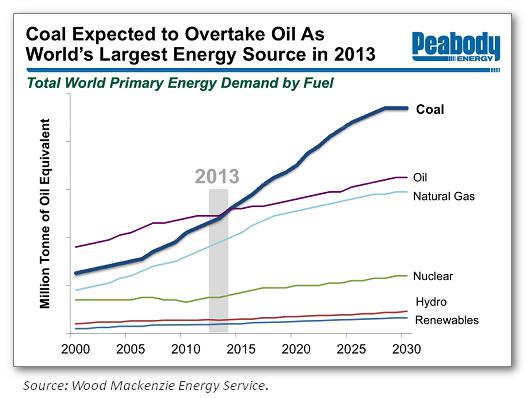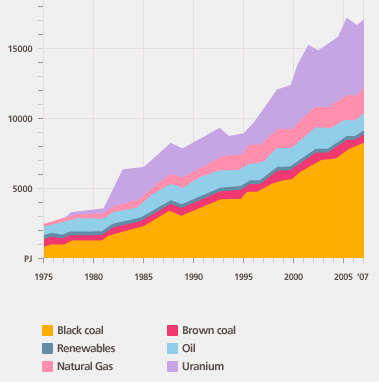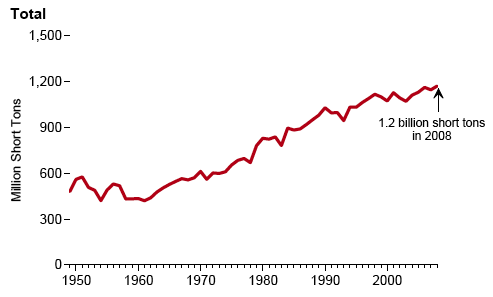The power and influence of the coal industry in nations like Australia and the US is evident in the fact that coal mining is expanding rather than being phased out in the face of global warming. The world market in coal is expected to increase by 300 to 400 million tonnes per year for the next five years and maybe longer. Over the last six years it has been the fastest growing energy source in the world and that it not exapcted to change in the future. ![]()
 The burning of coal produced 42 percent of global carbon dioxide emissions in 2008 and so coal is the largest single source of greenhouse gas emissions. The coal industry's initial response to global warming was to create doubt about the science. Today its main response is the promotion of the concept of clean coal. In each case it is opposed to the phasing out of coal.
The burning of coal produced 42 percent of global carbon dioxide emissions in 2008 and so coal is the largest single source of greenhouse gas emissions. The coal industry's initial response to global warming was to create doubt about the science. Today its main response is the promotion of the concept of clean coal. In each case it is opposed to the phasing out of coal.
The coal industry has also been active sponsoring school classroom materials that promote the use of coal (see here).

According to the Australian Coal Association (ACA) Australia is the world's largest coal exporter, and black coal is Australia's largest export. Coal exports are worth around $A50 billion a year. The largest market for Australian coal is Japan, which takes almost 40 percent of the coal.
In the past coal has enabled Australian industries to have cheap electricity and for industries such as steel-making to be more competititve. About one third of Australia's greenhouse gas emissions arise from burning coal in Australia, mainly to generate electricity.

The coal lobby likes to emphasise its contribution to jobs and the economy. However the industry only employs 32,000 people in Queensland and NSW, where most of the coal mines are, and much of the profit goes to overseas owners and shareholders. Far more people, some 170,000, lost their jobs due to globalisation and trade liberalisation, without the sort of concern that the coal lobby is trying to raise over coal mining jobs that might be lost as a result of the government's proposed emissions trading scheme.
The amount of carbon dioxide emissions that Australia exports is already double the amount that is emitted within Australia. Australian coal exports contribute around 3.3 percent of total global carbon dioxide emissions and together with domestic emissions this puts Australia in 6th place after the far more populous nations US, China, Russia, India and Indonesia. And even though the federal government has committed to reducing domestic carbon emissions by 5 percent on 2000 levels by 2020, exported carbon emissions over the same period are likely to increase by more than 100 percent.
The production of coal (see graph below) has not been reduced despite the threat of global warming. In fact expansion of coal mining and exports are still being planned. For example, exports of from the port of Newcastle in NSW are expected to double in the next five years and the NSW government concedes that this will require new coal mines to be opened.
According to the Australian Mines Atlas: "There are more than 35 proposed new mines, expansions and extensions which are at stages of development ranging from scoping studies to marketing."
Australian Energy Production

The Australian coal industry no longer publicly denies that burning coal contributes to climate change. In fact it is upgrading its coal loading facilities to be able to withstand the consequences of global warming. For example BHP Billiton will be "upgrading its coal export terminal at Hay Point, in Queensland - to better withstand climate-related extreme weather events. The new coal export terminal at Newcastle was also built up three years ago as modelling showed it could be vulnerable to storm surges and rising sea levels this century."
Nevertheless the industry refuses to consider that there is a need to reduce coal mining, domestic use or export of coal. Rather it argues that clean coal will solve the problem in the near future. It claims:
It is not the use of coal, but how coal is used that must be the focus for action.
To meet growing global demand, coal production is projected to rise by almost 60 per cent by 2030. Around 90 per cent of this increase comes from rapidly developing economies. For example, China will almost double its output, India’s production more than doubles, and Russian production jumps by nearly 75 per cent.
Ceasing the use of coal and other fossil fuels in order to cut greenhouse gas emissions is simply not a realistic option for the foreseeable future.
One of the most promising long-term solutions for reducing global greenhouse gas emissions from power generation is carbon capture and storage technology. It involves capturing the carbon dioxide (CO2) from large, stationary sources such as coal-fired power plants, compressing it for transport to an injection site, and then storing it safely and permanently deep underground....
Research and development is the key to reducing or eliminating greenhouse gas emissions from mining and use of coal.
In the meantime the coal industry has lobbied against the proposed emissions trading scheme arguing that it will be devastating to the coal industry, despite the promise of government compensation to coal-fired power stations.
The US is not a major exporter of coal, in fact 90 percent of coal mined in the US is used for electricity production, and contributes to just under half of all US electricity and one third of its carbon emissions.
US Coal Production 1949-2008

The coal industry in the US has run a number of astroturf campaigns in support of coal and set up a number of front groups including Families Organized to Represent the Coal Economy (FORCE), FACES of Coal, Americans for Balanced Energy Choices, Citizens for Coal Power, America's Power and Citizens for Clean Coal. The latter are all aspects of the American Coalition for Clean Coal Electricity (ACCEE), which spent more than $10 million on lobbying in 2008 alone.
 The American Coalition for Clean Coal Electricity (ACCCE), 'which is a partnership of the industries involved in producing electricity from coal' (list of members) spent almost $10 million on lobbying in its first year of operation, 2008 opposing global warming legislation. This included the establishment of front groups and artificial grassroots activities as detailed here.
The American Coalition for Clean Coal Electricity (ACCCE), 'which is a partnership of the industries involved in producing electricity from coal' (list of members) spent almost $10 million on lobbying in its first year of operation, 2008 opposing global warming legislation. This included the establishment of front groups and artificial grassroots activities as detailed here.
Western Fuels Association is "a not-for profit cooperative that supplies coal and transportation services to consumer-owned electric utilities throughout the Great Plains, Rocky Mountain and Southwest regions". During the 1990s it was an active participant in the global warming denial industry. It:
Former president of Western Fuels, Fred Palmer, headed the Greening Earth Society for 20 years and was chair of legal affairs for the National Mining Association, stated: "every time you turn your car on and you burn fossil fuels and you put CO2 into the air, you’re doing the work of the Lord." Today he is head of government affairs for Peabody Energy and is promoting 'green', zero emission coal as the way of the future. At one policy briefing in January 2010 his audience included "close to 100 administration and congressional staffers and policy experts". His last slide for the briefing is shown above courtesy of PolluterWatch.